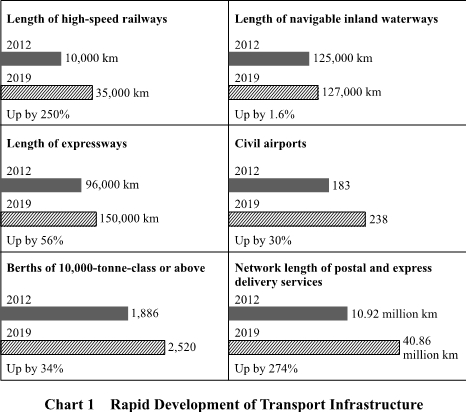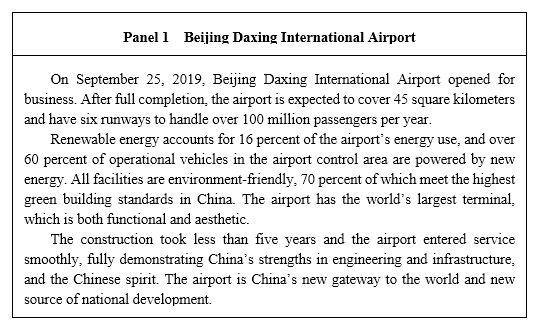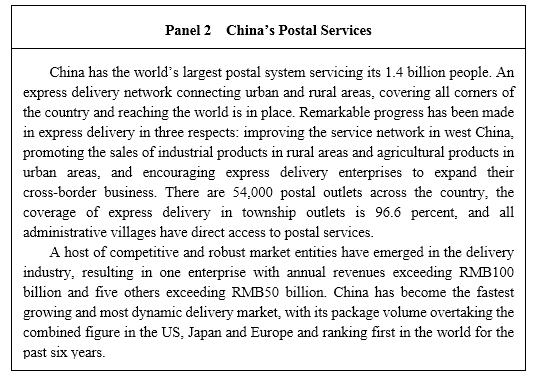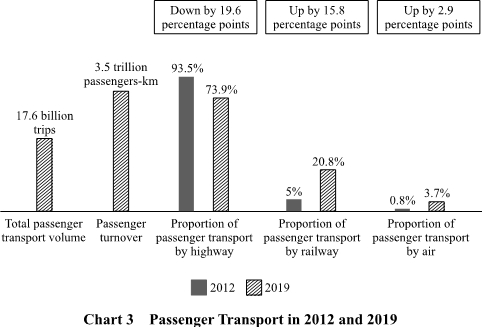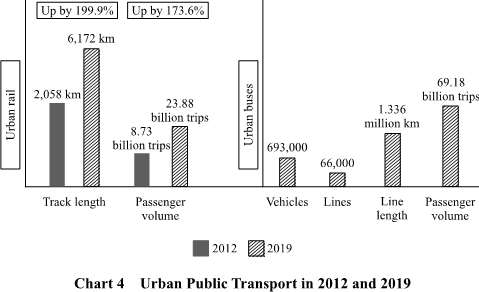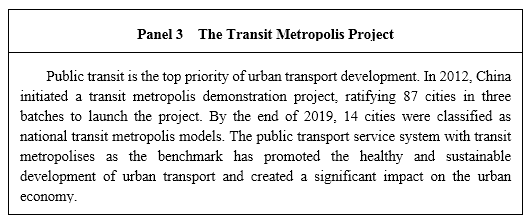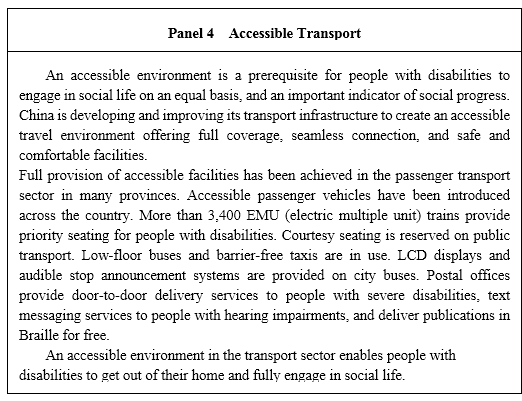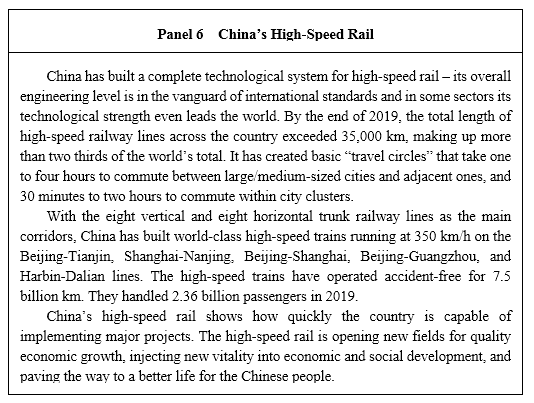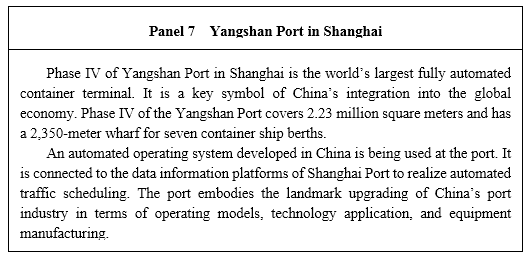Full Text: Sustainable Development of Transport in China
II. China's Growing Strength in Transport
In the new era, China is accelerating the high-quality development of its transport industry – it is seeing consistent progress in infrastructure construction, marked improvements in transport capacity, quality and efficiency, stronger technological support, greater accessibility and convenience, and more efficient freight transport. China is building up its strengthen in transport.
1. Creating a Comprehensive Infrastructure Network
China has taken advantage of a key window of opportunity to optimize the configuration of transport infrastructure and build it into a comprehensive network. The country has advanced supply-side structural reform in transport by bringing into service a group of passenger and freight hubs. The scale, quality and coverage of the comprehensive transport network have been significantly increased.
Forming a basic network for comprehensive transport infrastructure. By the end of 2019, China had a total of 139,000 km of rail track, of which high-speed lines represented 35,000 km, and a total of more than 5 million km of highways, of which expressways represented 150,000 km. The country had 23,000 operative berths, including 2,520 berths of 10,000-tonne-class or above, and 127,000 km of navigable inland waterways. There were 238 certified civil airports throughout the country. The long-distance oil and gas pipelines totaled 156,000 km with better connections achieved. The total network length of postal and express delivery services approximated 41 million km; every township had a post office and every village was provided with postal services. A comprehensive and multidimensional transport network has been put in place to give strong support to the sustained, rapid and healthy development of society and the economy.
Connecting the main transport corridors. The main transport corridors will be further expanded and connected to ensure China's territorial and energy security, and strengthen economic and political connections between regions. The state has devised ten vertical and ten horizontal transport corridors. Economic belts and city clusters are thriving along the transport corridors between Beijing and Shanghai, between Beijing and Guangzhou, along the Yangtze River and the coastlines, and near the ports in the Yangtze River Delta and Pearl River Delta and along the Bohai Sea Rim. They are becoming the most economically dynamic and populous areas in the country. Two thirds of the cities and 80 percent of the GDP of the Yangtze River Delta are concentrated along the high-speed transport corridors between Shanghai and Nanjing, and between Shanghai and Hangzhou. A rapid intercity transport network featuring high-speed railways, intercity railways and high-grade highways has been put in place in the Guangdong-Hong Kong-Macao Greater Bay Area.
A trunk network of gas pipelines is improving with the capacity to transmit gas from west to east China, from Sichuan to east China and from Shaanxi to Beijing, and to bring gas from offshore. Coal logistics corridors are better configured, and a railway corridor for energy transport running across the country has taken shape. The main logistics corridors for grain have been connected, and the container volumes of unprocessed grain, bulk grain and refined grain have increased significantly, along with improved efficiency in grain logistics. Flow of people and goods is more convenient between regions. An open and comprehensive transport network that crosses the whole country and connects with the world has taken shape.
Building integrated transport hubs. By giving full play to the hub economy and actively fostering new drivers of growth, China has promoted the integration of transport, logistics, and information with society and the economy. Considering the national urban configuration, the country has built international transport hubs in Beijing, Shanghai and Guangzhou, and created more transport hubs at national and regional levels. Highlighting the need for integrated transport terminals, a group of such projects have been completed, such as the Beijing Daxing and Shanghai Hongqiao hubs, integrating airport transport seamlessly with high-speed and standard rail, and urban passenger transport.
The configuration of freight terminals and logistics parks has been optimized for multimodal and multilevel transport. A number of modern logistics hubs, such as Yangshan Port in Shanghai and the railway inland port in Zhengzhou, have helped to improve the transshipment capacity, enhance multimodal transport, and create a comprehensive transport system. The integration of various transport methods at these hubs provides strong support for optimizing the economic structure and modernizing the economic system.
Strengthening systematic planning for urban transport infrastructure. By the end of 2019, the total length of urban roads across the country was 459,000 km, the road area per capita 17.36 sq m, the road network density in the urban built-up areas was 6.65 km/sq km and the road area ratio 13.19 percent. The government has strengthened planning for a comprehensive urban transport network and improved effective transport connections between cities and neighboring areas.
With a concept of "narrower roads and a denser network", China has built an urban road network featuring a reasonable composition of expressways, arterial roads, sub-arterial roads and branch roads friendly to green travel. The transport authorities have improved road space allocation to fully ensure the needs of green travel and regulated the provision of traffic safety and management facilities. The country has carried out campaigns to clear up sidewalks and build bike paths to improve the environment for green travel.
2. Optimizing Transport Capacity and Quality
China has made all-round improvements to the quality of transport. The rapid growth of Internet Plus Transport and other new business models has offered more equitable access to more diversified services of higher
quality, facilitating the movement of people and goods, and strengthening the accessibility and support functions of transport. Transport is playing a stronger role in supporting the nation's economic and social development, and in promoting investment, stimulating consumption, and sustaining growth.
Enhancing freight transport capacity. China is one of the busiest freight hubs in the world. The increasing demand for freight capacity requires China to accelerate multimodal transport, create efficient and innovative transport links such as rail-highway, air-rail, rail-waterway and river-sea transport, ship-to-ship transfer, and roll-on/roll-off shipping.
China has also implemented programs to raise railway transport capacity, upgrade waterway transport, and regulate highway freight transport. The freight transport structure has been optimized, overall transport efficiency has improved, and logistics costs have been lowered. A marked decrease has been seen in transport pollution. The construction of pipelines for crude oil, refined oil and natural gas is accelerating. The proportion of rail transport in total freight transport is increasing. Visible results have been achieved in shifting more freight transport from road to railway. The cargo throughput and container throughput in China's ports both rank first in the world. Express delivery continues to flourish, and has led the world for the past six years. Substantial growth in transport service capacity has accelerated progress in reducing costs, increasing efficiency, and upgrading the logistics industry.
Meeting the public's expectation for quality travel. Passenger transport is becoming more professional and personal, meeting the public's expectation for a better, faster, more convenient, more comfortable, and satisfying travel experience. With road transport as the base and high-speed rail and civil aviation as the direction of future development, the transport service structure is improving. The trend is for passengers on middle- and long-distance journeys to shift from highway travel to high-speed rail and planes. By the end of 2019, 12 billion trips had been made on high-speed rail, and its share of total rail passenger transport had risen from 4.5 percent in 2007 to 65.4 percent.
The transport capacity and service during the Chinese New Year holiday, National Day holiday, and other travel peaks have significantly increased. People can now take a trip whenever they want, and enjoy quality and professional service that makes travel a comfortable and satisfying experience.
Prioritizing the sustainable development of urban public transport. Modern cities aspire to provide high-quality public transport, and take effective measures to strengthen urban traffic management and enhance the life quality of urban citizens. Great efforts have been made to improve urban rail services. By the end of 2019, a total of 40 cities had opened urban rail transit lines, with 6,172.2 km of track. While the role of rail transit is increasingly visible, the number of people using public transport for travel is also growing, and the level of comfort is improving.
Rapid development has also been seen in non-motorized transport. More than 70 cities have released administrative measures to regulate bike-sharing, and over 360 cities provide bike-sharing services. Public transport offers convenient travel by meeting the public's diverse travel needs.
Ensuring equal access to basic public services. To promote social harmony, the Chinese government is committed to ensuring equal access to public transport services. Low-fare low-speed trains in remote areas which stop at every small station and have a similar function to buses, serve as a bridge between mountainous villages and cities. These trains provide a convenient public welfare service to people along the line and facilitate their efforts towards a better life.
The nationwide expansion of highway passenger transport and rural logistics has helped to integrate rural and urban areas. By the end of 2019, integration of rural and urban transport had been piloted in 52 counties; 95 percent of urban districts and counties nationwide had achieved AAA ratings in urban-rural transport integration, and 79 percent had achieved AAAA ratings.
Accessible transport provides convenience for people with disabilities, and barrier-free access has been implemented at public transport hubs including train stations, highway service areas, passenger ship terminals, airports, and postal outlets. Further measures are being implemented to provide universal services and help people share in the fruits of transport development.
Encouraging new models and forms of business in transport. Internet Plus models in transport are having a profound impact on the way people travel. By the end of 2019, more than 400 cities across the country had online car-hailing services, with daily usage averaging 20 million trips. Bike-sharing has effectively bridged the last kilometer in urban travel, with daily usage averaging more than 45.7 million trips.
The penetration of Internet Plus into freight logistics is accelerating, and inspiring organizational innovations. The 95306 online platform for railway freight services was put in place. In 2019, the online rail freight service handling rate rose to 85 percent. 229 non-truck operating common carriers integrated 2.11 million freight vehicles, improving the utilization rate by 50 percent, lowering the freight transaction cost by six to eight percentage points compared with traditional ways. The integration of the internet and high-speed railway network has seen remarkable results. In 2019, a total of 3.57 billion tickets were sold on 12306.cn, China's official website for booking train tickets. Electronic tickets can be bought at almost all railway stations. China is on the way to achieving full WIFI coverage in high-speed trains and stations. It has also made innovations to roll out services such as online meal booking, wireless charging and intelligent interaction.
By the end of 2019, over 98 percent of the bus terminals at the county level and above offer province-side online ticket booking services. The new online and offline forms of passenger transport such as car-hailing, bike-sharing, and car-sharing services, and new forms of business such as facial recognition check-in at railway stations, paperless boarding at airports, drone delivery, contactless delivery, intelligent parking, and customized passenger transport services have brought convenience to people and injected fresh momentum to economic growth.
Supporting major strategies for regional development. China has strengthened the transport configuration to support and serve the strategy to coordinate the development of the Beijing-Tianjin-Hebei Region, the Yangtze River Economic Belt, the Guangdong-Hong Kong-Macao Greater Bay Area and other regions. The country has accelerated to build multi-junction transport matrices for world-class city clusters, and a first-class comprehensive transport system in the Xiong'an New Area. Efficient connections between trunk, intercity, suburban and urban rail have been achieved, with a focus on facilitating Beijing-Tianjin-Hebei integration.
In its efforts to systematically manage major waterways, China has mitigated the traffic bottleneck along the Three Gorges Dam, improved the function of the Yangtze River as the golden waterway, and endeavored to build a transport corridor along the Yangtze River Economic Belt. To create a modern and comprehensive transport network in the Guangdong-Hong Kong-Macao Greater Bay Area, the country has opened up transport corridors in the east, west and north of Guangdong connecting the Greater Bay Area with surrounding provinces and regions, and aimed to build an international overland transport corridor linking the pan-Pearl River Delta with the Association of Southeast Asian Nations (ASEAN).
To support the Hainan Free Trade Port, China has built a multi-junction, province-wide transport matrix of railways, intercity rail, and main highways in Hainan, focusing on the Haikou-Chengmai-Wenchang Economic Integration Circle and the Greater Sanya Tourism Economic Circle. To promote better and integrated transport in the Yangtze River Delta, the country has built a multilevel, well-connected transport network with Shanghai, Nanjing, Hangzhou, Hefei, Suzhou, Wuxi, Changzhou and Ningbo as the junctions.
In line with the need for eco-environmental conservation and territorial space development in the Yellow River Basin, China has coordinated the development of the transport corridors, hubs and network in the river basin. Targeted transport measures in various regions have been designed to support their respective strategies.
3. Moving from Follower to Leader in Transport Technology
China's capacity for innovation in transport has strengthened - it possesses self-developed core technologies, and has made major breakthroughs in transport infrastructure and equipment. Capacity for sustainable development is growing. China is making steady progress from a follower to a leader in transport technology.
World-leading mega-projects. China leads the world in technology for railways at high altitudes and in extremely low temperatures, and for high-speed and heavy-haul railways. It has solved the most challenging technical problems confronting highway construction in difficult geological conditions such as plateau permafrost, expansive soil, and desert. It also leads in core technologies for building deep-water offshore ports, improving massive estuary and long waterways, and building large airports.
The Beijing-Guangzhou High-speed Railway, the longest high-speed rail line in the world, has been completed. The Lanzhou-Urumqi High-speed Railway has the world's longest line that has been built at one go. The Harbin-Dalian High-speed Railway, the world's first high-speed rail line operating at low temperatures in winter is open to traffic. The Datong-Qinhuangdao Heavy-haul Railway ranks top in the world in terms of annual transport volume. The Xueshan No. 1 Tunnel, the world's highest of its kind, built in Golog Tibetan Autonomous Prefecture, Qinghai Province, has been opened to traffic. The section of the Sichuan-Tibet Railway between Ya'an and Nyingchi is under construction.
Other notable mega-projects include the Hong Kong-Zhuhai-Macao Bridge, the Xi'an-Chengdu High-speed Rail cutting through the Qinling Mountains, the container terminal at Yangshan Port, the automated container terminal at Qingdao Port, and the deep-water channel improvement project in the Yangtze River Estuary.
China leads the world in the total length and number of highway bridges and tunnels in service and under construction. It has seven of the ten longest cable-stayed bridges, six of the ten longest suspension bridges, six of the ten longest cross-sea bridges, and eight of the ten highest bridges in the world.
Major breakthroughs in transport equipment technology. Aiming to develop cutting-edge core technologies, China has substantially improved the level of its independent research in key transport equipment technology. China has set a world record by successfully testing its self-developed Fuxing EMU trains running at 420 km/h in intersection and coupled operations. The Fuxing EMUs have been running at 350 km/h – the highest operating speed in the world – on the Beijing-Shanghai High-speed Rail, the Beijing-Tianjin Intercity Rail and the Beijing-Zhangjiakou High-speed Rail. China became the first in the world to realize autopilot on trains running at a speed of 350 km/h. 600 km/h prototype maglev trains and high-speed free gauge trains running at a speed of 400 km/h that can change tracks and are capable of making international trips have rolled off the production line.
Major breakthroughs have been achieved in tunneling technology – earth pressure balance, hard rock, and slurry shield machines with the world's largest operating diameters have been developed. The fuel-efficient and new energy vehicle industry is prospering, keeping abreast of the latest international advances. The manufacturing technologies for special marine engineering machinery vessels and complete sets of large automated and specialized container handling equipment rank top in the world. China has also made innovative breakthroughs in 300-meter saturation diving. The C919 large passenger aircraft has made its maiden flight. The ARJ21 regional jet is now in commercial service.
The sorting technology in express delivery is developing rapidly. China leads the world in building ocean-going vessels, high-speed EMU trains, high-power locomotives, and marine engineering machinery. Its burgeoning equipment technology in large aircraft and new-generation intelligent connected vehicles is on the way to becoming a major international calling card for China's manufacturing.
Expedited development of intelligent transport. China is developing transport featuring Internet Plus to fully integrate modern information technology with transport management and services. The country has applied emerging technologies such as 5G, big data, and artificial intelligence to transport infrastructure and equipment, and has made breakthroughs in research and development of intelligent transport. Electronic ticketing and online booking have become increasingly popular in railway, highway, waterway and civil aviation passenger services, the application of IT in transport management has significantly increased. By the end of 2019, 229 airports and major airlines have realized paperless travel.
China has removed all expressway toll booths at provincial borders across the country. Positive results have been achieved in the application of new technologies such as Electronic Toll Collection (ETC) on expressways. By the end of 2019, there were more than 200 million ETC users across the country. Round-the-clock, all-weather and full-coverage monitoring of the road network and information distribution are strengthening.
The BeiDou Navigation Satellite System (BDS) has been applied to 7.6 million vehicles on the road, 33,300 postal and express delivery trucks, 1,369 public service vessels, 10,863 maritime navigation facilities, 109 coastal ground-based augmentation stations, 352 general-purpose aircraft, and three transport aircraft. The Beijing-Zhangjiakou High-speed Rail featuring autopilot is the first in the world to use the BDS. Intelligent highway technologies are further promoted, and intelligent port and shipping technologies are widely used. Intelligent delivery outlets are found everywhere in all major cities, and automated sorting has been adopted by all major distribution centers of express delivery enterprises.
China has released administrative rules on road testing of self-driving vehicles, technical guidelines on the construction of enclosed testing fields for autopilot, and rules on intelligent ships. It has built a test area for unmanned cargo ships and piloted the use of drones in delivery services.
